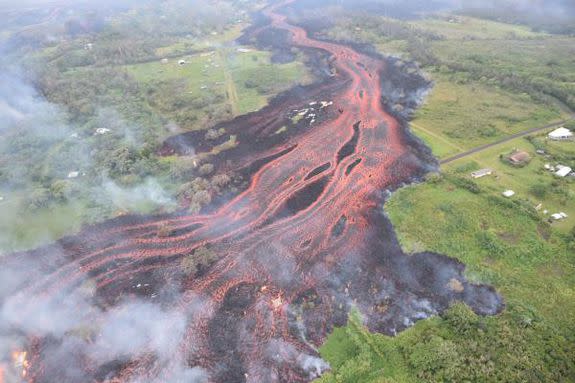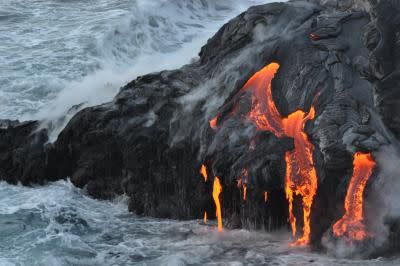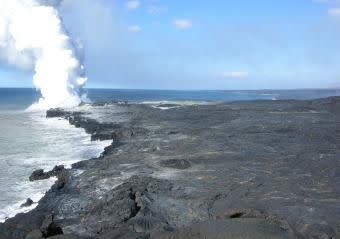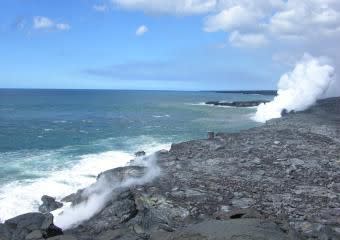Hawaii's destructive lava flows hit the ocean, making the Big Island bigger

The history of Hawaii is a tale of lava flowing into the sea.
Bounties of fresh lava poured out of the Kilauea volcano's recently opened fissures this weekend, producing orange molten rivers that flowed downslope to the Pacific Ocean. When they met, the lava chilled into rock while creating plumes of acidic steam.
These lava flows, while devastating for homes in the way of these flows, will gradually add new land to the Big Island, continuing a long geologic history of natural island-building.
"This is the common way in which the island grows laterally," George Bergantz, a volcanologist at the University of Washington, said in an interview. "It's lava flow, on top of lava flow, on top of lava flow."
SEE ALSO: Deep beneath the Pacific, another active Hawaiian volcano waits to emerge
Not every addition to the Big Island involves an eruption that puts people at risk and engulfs their communities. For decades, Kilauea has experienced continuous lava flows through a vent called Puʻu ʻŌʻō in Hawaii Volcanoes National Park, incrementally adding land to the southeast portion of the island.
This continuous flow has added 570 acres of land to Hawaii's Big Island since 1983, according to the U.S. Geological Survey's most recent update. Meanwhile, the lava has also blanketed over 40 square miles of rainforest, communities, and historical sites.
#NOAA20 satellite captured the light from the lava glowing through the clouds from Hawaii's #Kilauea's fissure 20 🌋. On May 11th, we shared imagery of the Halemaʻumaʻu crater draining prior to the recent eruption. pic.twitter.com/cTjtPqKukF
— NOAA Satellites (@NOAASatellites) May 21, 2018
Things changed dramatically in early May, when lava began spewing from a new area on the volcano, engulfing homes and roads. In a separate event, the volcano exhibited rare, explosive activity, sending ash tens of thousands of feet into the sky.
In other words, the ash-filled eruptions and massive evacuations are unusual — but lava flows from Kilauea are not. It's also normal for lava to reach the sea in steamy, even explosive meetings of heat and water.

Image: usgs
The Big Island's new land, however, is far from stable. The young, cooled rock is constantly pounded by waves. And as this new land settles down and sinks, sea water can find its way in through cracks, creating bursts of lava.
"You’re going to be adding land, but it's incredibly unstable," Michael Poland, of the USGS's Yellowstone Volcano Observatory, said in an interview. "Everything about it is unstable."

Image: USGS
Sometimes, this natural land-building can take a sizable step back — specifically, by collapsing.
"Occasionally you’ll get collapses that eat into the landscape," said Poland.
"It's a construction-deconstruction process," said Bergantz.
Before collapse

Image: Usgs
After collapse

Image: usgs
So, it's wise to stay off this fresh, unsettled earth. Even if new land extends just 10 or 20 feet offshore, the USGS recommends standing at least 330 yards away, as collapses and toxic plumes aren't just possible — they've killed people ignoring signage.
Eventually, the land will stabilize. This requires one common ingredient: more lava flows.
"If you get enough lava coming in, it’ll start growing itself laterally to form a much more solid and coherent set of lava flow benches [or landforms]," said Bergantz.

For now, considerable amounts of fresh lava continues to spatter, fountain, and pour out of recently opened lava fissures, incrementally adding new — though still unstable — land.
"It's just remarkable what's going on there right now," said Bergantz.
WATCH: Boeing's 777X wingtips will fold to let it squeeze into narrow airport gates


